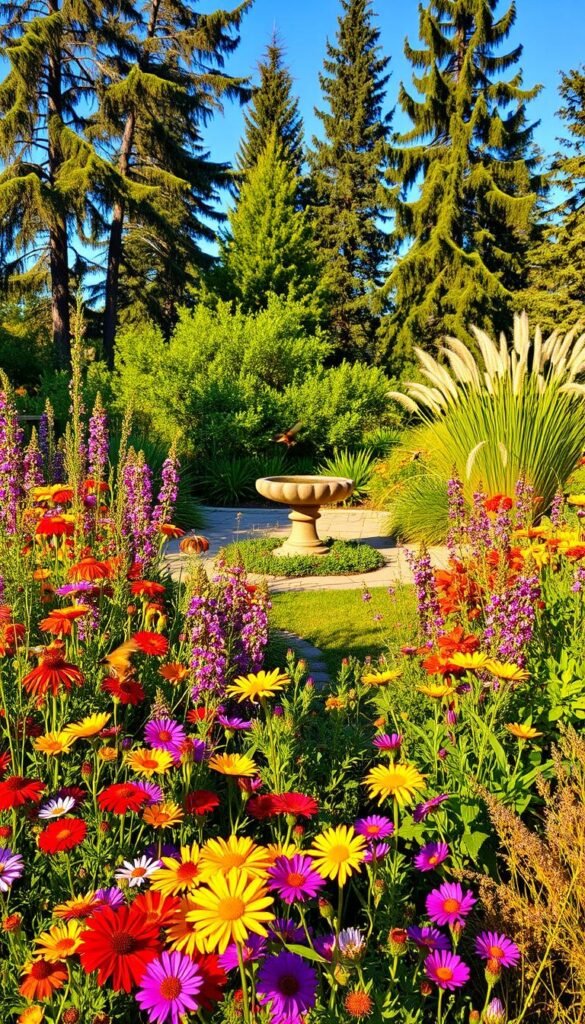Did you know that tiny creatures like bees and butterflies keep our ecosystems thriving? The U.S. Fish and Wildlife Service highlights their vital role in food production and biodiversity. Even a small balcony or patio can become a sanctuary for these essential pollinators.
By choosing the right plants and flowers, you create a living landscape that offers food and shelter year-round. This approach not only supports wildlife but also transforms your space into a colorful retreat. Discover how to design a thriving habitat with native species and organic methods.
Ready to learn more? Explore our guide on selecting nectar-rich blooms to get started. Every season brings new opportunities to nurture nature’s helpers.
Why Create a Pollinator Garden?
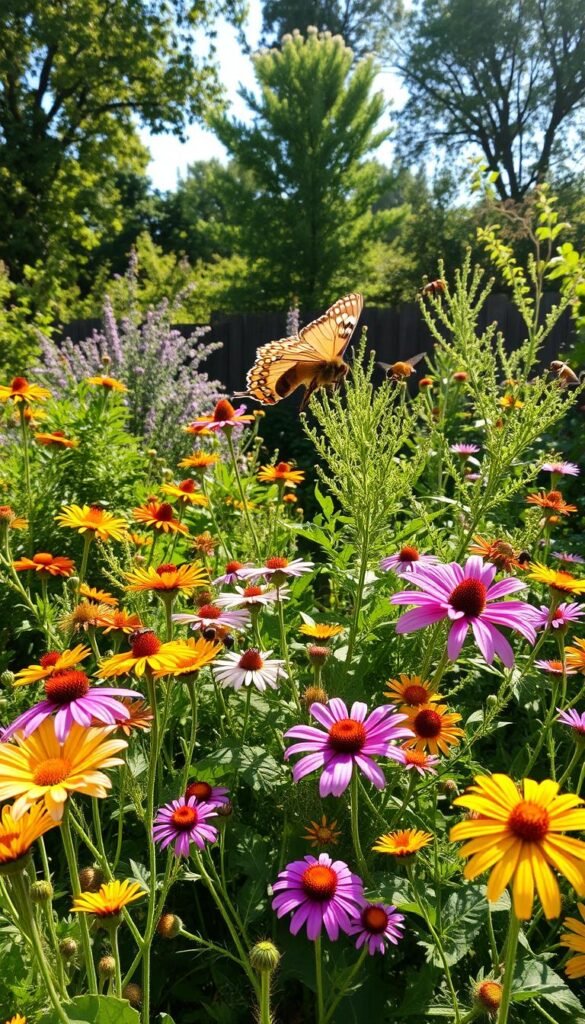
Imagine biting into an apple—thank a pollinator for making it possible. These tiny workers, like bees and butterflies, ensure 75% of flowering plants and 35% of global food crops thrive. Without them, grocery shelves would look starkly different.
Yet, 40% of invertebrate pollinators face extinction due to habitat loss. Urban spaces, like your garden, can bridge gaps between wild areas. They offer protection and nectar-rich blooms for insects to survive.
Beyond ecology, tending to these spaces reduces stress. Studies show digging in soil boosts mood. For kids, watching a caterpillar transform into a butterfly teaches patience and wonder.
Native plants are key—they’ve evolved with local pollinators over centuries. By planting them, you restore balance. Every bloom counts in reversing decline.
Planning Your Backyard Pollinator Garden
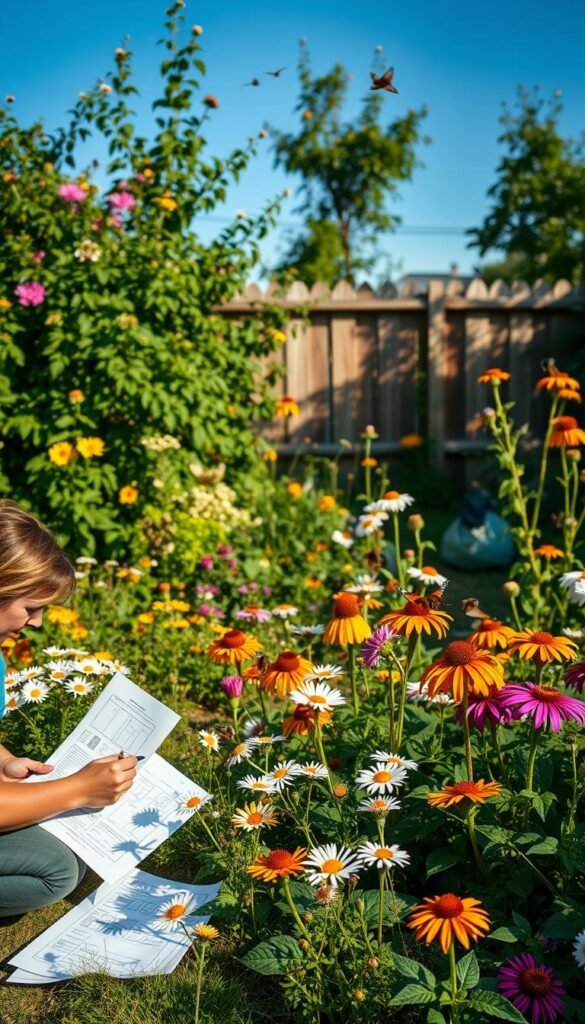
A thriving habitat starts with smart planning—sun, soil, and space shape success. Before picking plants, assess your site’s conditions to create a resilient ecosystem.
Choosing the Right Location
Butterflies adore sun-basking spots but need wind protection. Observe your space:
- Full sun (6+ hours) fuels nectar-rich blooms like coneflowers.
- Partial shade suits woodland species such as columbine.
- Slopes? Steeper areas drain faster—ideal for drought-tolerant plants.
“Use the USDA’s soil mapper tool to analyze local conditions.”
Assessing Soil and Sunlight
Test your soil’s texture with the ribbon method:
- Roll damp soil between your fingers.
- If it forms a ribbon, it’s clay-heavy; crumbly means sandy.
Microclimates matter too. Pavement radiates summer heat, while tree shade cools. Raised beds fix poor drainage.
Selecting the Best Plants for Pollinators
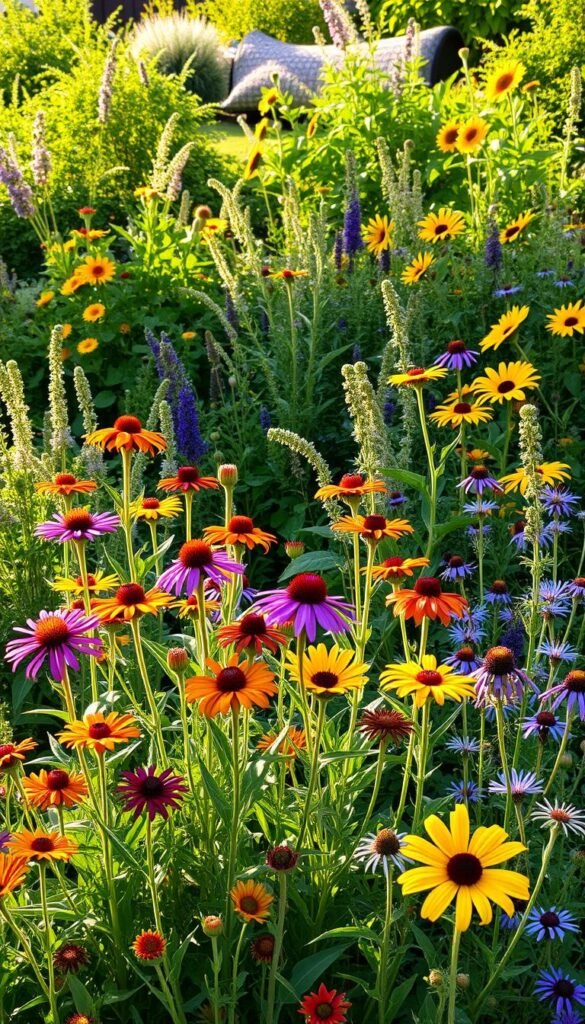
Monarch butterflies won’t survive without one critical native plant: milkweed. Their caterpillars eat only its leaves, making it non-negotiable for a thriving habitat. Your choices directly impact which species flourish.
Native Plants vs. Non-Native: What to Prioritize
Native plants evolved with local pollinators over centuries. They offer the right pollen and nectar balance. For example, purple coneflower supports 25+ bee species, while exotic tulips feed almost none.
Use the National Wildlife Federation’s Native Plant Finder to discover regional stars like:
- Goldenrod (Solidago) for late-season bloom.
- Spicebush (Lindera) for swallowtail butterflies.
- Redbud trees for early spring flowers.
“Avoid ‘double bloom’ cultivars—their extra petals block nectar access.”
Plants That Bloom Seasonally
Aim for three-season bloom cycles to provide continuous food:
- Early: Crocus, willow shrubs (March–May).
- Mid: Bee balm, sunflower (June–August).
- Late: Asters, Joe-Pye weed (September–frost).
Group plants in clusters of 3–5 so pollinators forage efficiently. Pair perennials like milkweed with annuals like zinnias for color variety.
Pro Tip: Source pesticide-free plants from local nurseries. Big-box stores often treat stock with harmful neonics.
Planting Your Pollinator Garden
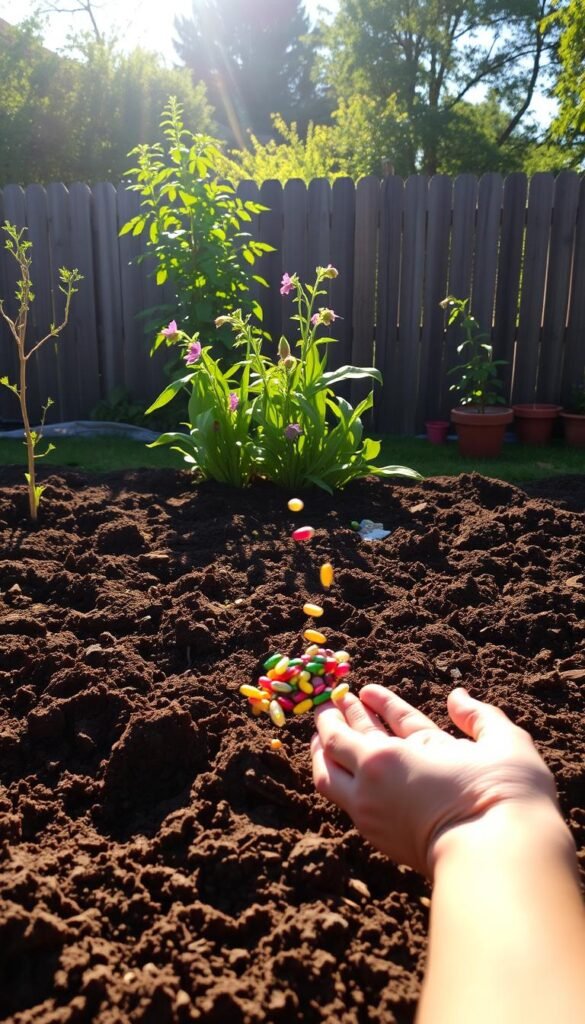
Whether you start with tiny seeds or established greenery, each method has unique perks for your space. Your choices impact how quickly pollinators find food and shelter. Let’s dig into the best approaches.
Seeds vs. Starter Plants: Pros and Cons
Seeds cost less but demand patience. Native species often need stratification—exposure to cold or moisture to sprout. Try winter sowing: scatter them over snow in late February. Meltwater tucks them into the soil naturally.
Starter plants from nurseries bloom faster, ideal for small areas. Look for pesticide-free options. A 4-4-4 organic fertilizer boosts soil health without harsh chemicals.
Step-by-Step Planting Guide
Transplant on cloudy days to reduce shock. Handle rootballs gently—tease apart tangled roots before placing them in holes. For no-till beds, layer cardboard, compost, and mulch (lasagna gardening). This smothers weeds and enriches soil over time.
- Tools: A dibber makes seed holes; a hori-hori knife tackles tough roots.
- Water deeply after planting to help roots settle.
- Group perennials like coneflowers in clusters for efficient foraging.
“UV ‘nectar guides’ on blooms direct insects to food—like runway lights for pollinators.”
For more tips, explore the FWS guide to pollinator habitats. Every step you take builds a safer haven for nature’s workers.
Maintaining a Thriving Pollinator Habitat
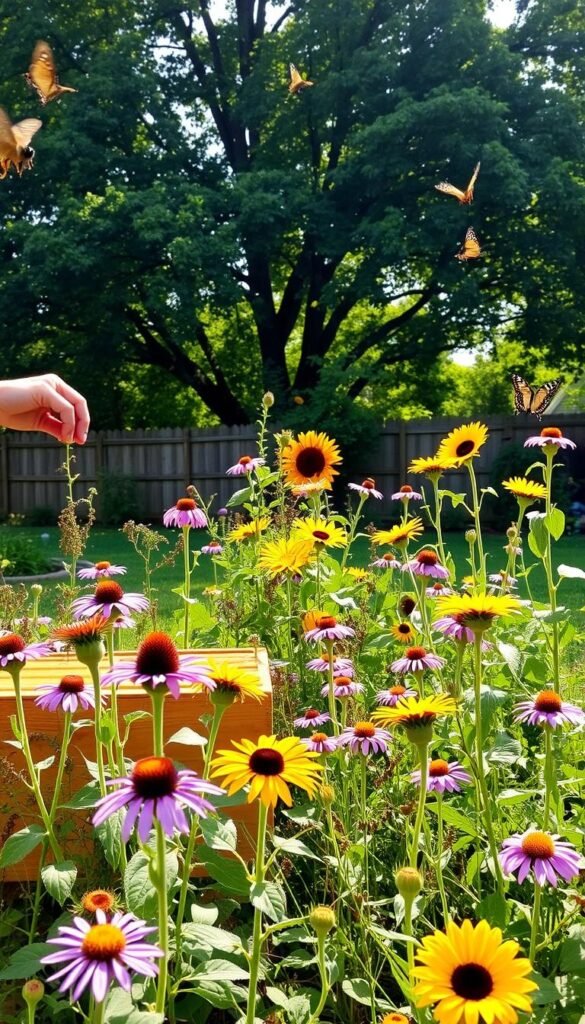
Healthy habitats need smart care—just like your favorite houseplant. Consistent attention to water, weeding, and organic practices keeps your space buzzing with life. Small efforts yield big rewards for both plants and pollinators.
Watering and Weeding Strategies
Drip irrigation conserves water and prevents fungal growth. Soaker hoses deliver moisture directly to roots, reducing waste. In summer, water deeply before sunrise to minimize evaporation.
Hand-weeding protects delicate root systems. Leave some clover or dandelions—they’re nutrient-rich for bees. Try “messy gardening”: fallen leaves shelter chrysalises through winter.
Organic Pest Control
Avoid broad-spectrum pesticides that harm beneficial bugs. Instead, invite predators like ladybugs and lacewings. They devour aphids naturally.
| Pest | Organic Solution | Timing |
|---|---|---|
| Slugs | Beer traps | Dusk |
| Mildew | Neem oil spray | Early morning |
| Aphids | Soap-water mix | Cool evenings |
“Apply treatments at dusk when pollinators are least active—safety first.”
For stubborn pests, use targeted products like Sevin Insect Killer. Always spot-test and follow organic guidelines. Your habitat thrives when balance replaces chemicals.
Attracting Specific Pollinators to Your Garden
Different species have unique needs when it comes to food and shelter. By tailoring your space, you can welcome a diverse range of winged visitors. Here’s how to create an inviting environment for bees, butterflies, and hummingbirds.
Plants for Bees and Butterflies
Bees love bright colors, especially blue and purple. They’re drawn to flat or shallow flowers like coneflowers and sunflowers. These provide easy access to pollen and nectar.
For butterflies, plant milkweed or passionflower. These serve as host plants for caterpillars. Add zinnias or lantana for adult butterflies to feed on. Their sweet fragrance and vibrant petals act like a beacon.
Did you know bees see UV patterns on flowers? These guides help them locate food faster. White blooms attract night-flying moths, adding another layer of diversity.
Creating a Hummingbird Haven
Hummingbirds prefer tubular-shaped blooms like cardinal flower and bee balm. The bright red and orange hues catch their eye. These flowers hold rich nectar deep inside.
Set up a red feeder with a 4:1 water-to-sugar ratio. Avoid dyes—they’re harmful. Place it near trumpet vines or salvia for a natural look. The birds will dart between feeder and plants.
For more ideas on container-friendly options, check out our guide on flowers that attract pollinators. Even small spaces can make a big impact.
“Cluster purple salvia with white alyssum—the high contrast draws more species.”
Shallow dishes with stones make perfect drinking spots. Butterflies use them as puddling stations, while bees sip water between flights. It’s a simple touch that supports all your visitors.
Your Garden’s Role in a Pollinator-Friendly Future
Your green space becomes a lifeline for struggling species. Even a 3×3-foot bed can host 15+ types of pollinators, proving small efforts matter. Urban patches collectively rival wild areas in supporting biodiversity.
Join projects like Bumble Bee Watch to track species. Share divisions of native plants with neighbors—spreading milkweed or coneflowers strengthens the ecosystem. Pledge to keep your plot pesticide-free; one Ohio family’s yard became a monarch waystation this way.
These actions offset agricultural monocultures. Over time, your garden feeds pollinators and teaches kids stewardship. Learn how families can help in our pollinator haven guide.
Become an ambassador. Inspire others to plant for all seasons. Together, we weave a pollinator-friendly future—one bloom at a time.

